History
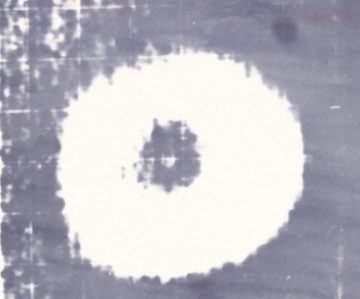
Wihuri Physical Laboratory was founded over 60 years ago. Since then we have made high-class basic research from which our society have significantly benefited from. For instance Finland’s first magnetic resonance image was taken in 1981. Later, magnetic resonance imaging has become indispensable for the medical sciences.
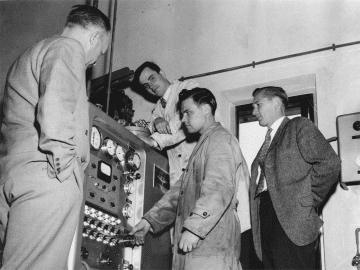
Here in Wihuri Physical Laboratory we have studied for example cosmic radiation and specific heat capacities of rare earth metals. But the main focus of our research has always been in solid state and low temperature physics. We have been doing research on quantum mechanical phenomena including superconductivity, Bose-Einstein condensation and many properties of magnetic materials.
Wihuri Physical Laboratory was established in 1957, when Jenny and Antti Wihuri Foundation provided funds for the University of Turku to get a Collins helium liquefier. When the Collins helium liquefier was installed it was the first in Finland, second in the Nordic countries and 82nd in the entire world.
In the beginning
Väinö Hovi was the first director of Wihuri Physical Laboratory. He was in this position for the first two decades. During that time he decided everything concerning the laboratory and pulled all the strings inside and outside this domain.
In the beginning there where several research groups. The number and the fields of expertise have changed during the history of facility from scattering aims to organised hunger for knowlegde.
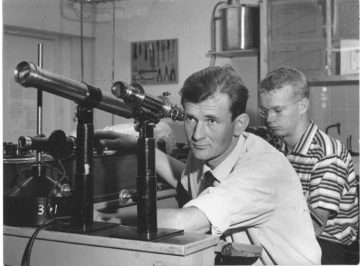
- In 1959 research included, studying certain peculiarities in the thermal expansion of ammonium chloride as well as using ultrasound to find out the elasticity in solids at low temperatures.
- In the year 1960 the laboratory received a large grant from the Jenny and Antti Wihuri Foundation. With that money they purchased a a Varian nulear magnetic resonance setup. Within the next few years the Wihuri Foundation also provided the funds to buy a X-ray diffractometer and a electron microscope.
- Professor Hovi was fascinated in the phenomena that happens when substance undergoes a phase transformation and their energies. The laboratory studied these phenomena in the beginning, in the basement area K55.
Cosmic radiation
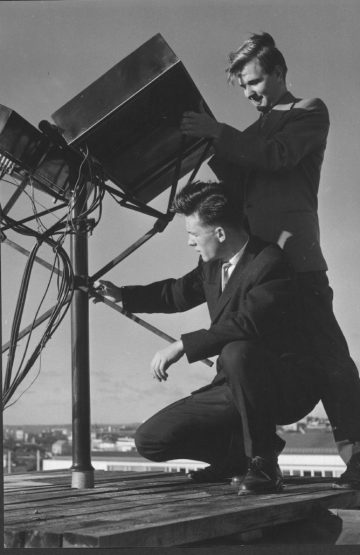
In 1958 a new research group was launch which concentrated on cosmic radiation research.
At first all of the research devices were on the ground for example in the end of 1950s they build their first telescope, which consisted of several Geiger counters. Later the space devices replaced the research done on the ground.
In 1987 Finland joined European Space Agency, ESA, as an associate member. This open the chance to propose research equipment for the upcoming space projects. This group had already made research on solar particles so they suggested to send a equipment to space which measured solar particles. In 1995 they launched ERNE (Energetic and Relativistic Nuclei and Electron experiment) in space with SOHO (space probe). ERNE researches the ion and electron composition of high energy particle radiotion originationg in solar eruptions
With the university reforms of 1990 the Cosmic Radiation Group was separated from the Wihuri Physical Laboratory to form its own Space Research Laboratory
NMR group
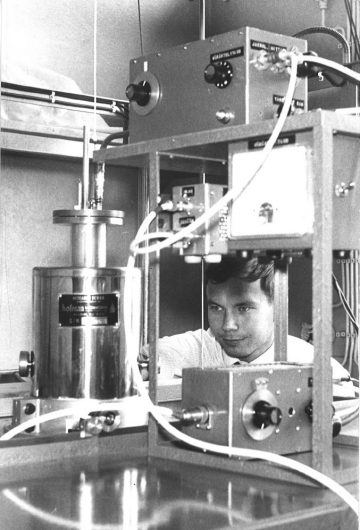
Nuclear magnetic resonance (NMR) spectrometry is a tool for studying structures of different molecules. The most famous application for this phenomenon is MRI (magnetic resonance imaging) scanning which is used in hospitals all over the world.
From the beginning Wihuri Physical Labratories NMR studies have concerned solid state physics. In 1960 the laboratory got a large grant from Wihuri Foundation which made it possible to purchase a Varian electromagnet. This electromagnet reached fields up to 1 tesla which was at the time very strong by the Finnish standards.
In 1972 Wihuri Foundation sponsored the laboratory with their first commercial NMR spectrometer. On top of that in 1984 the group got a 7 T superconducting magnet as well as a new Bruker 300 MHz spectrometer four years later.
Some research topic throughout the history:
- In 1960s the NMR group studied among others acoustic and electrically induced nuclear magnetic changes in ionic crystals as well as the rotation and reorientation of ions in solids. Especially the study on reorientation kept the group busy for years
- In 1970s the studies included among others nuclear magnetic resonance in antiferromagnetic materials and some research was also made for physiological uses.
- In the early 1980s the first MRI image in Finland was taken in the Wihuri Physical Laboratory. This image presented a cross-section of an olive. The group also studied electric spin resonance (ESR) with an ESR spectrometer during that time. It gave us more information on studying properties of different materials.
- In the 1990s the aim was also in general to study the molecular and atomic movement and energy states especially at low temperatures
Atomic Hydrogen
In 1977 the Wihuri Physical Laboratory got a new professor, Matti Krusius. He established a new group which focused on spin-polarised atomic hydrogen. The group is still very active and conducts research at temperatures below 1 kelvin in high magnetic fields.
So that they could conduct their research they needed equipment that would reach ultra-low temperatures. Therefore they started to build a setup based on dilution refrigerator. The construction work was completed in 4-5 years.
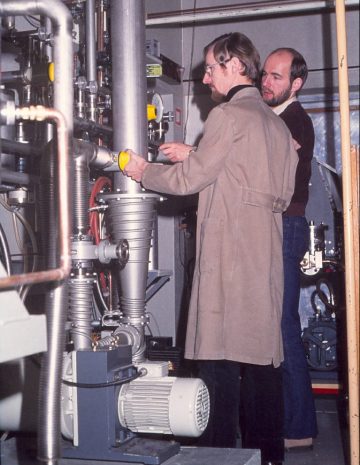
At present, the Turku Atomic Hydrogen Group of the Wihuri Physical Laboratory runs three different projects:
- The oldest and globally well-known is the research concerning atomic hydrogen gas in temperatures under 1 kelvin.
- The second research project aims to reach so-called Bose-Einstein condensate (BEC) state, which appears at sufficiently low temperatures of matter when the thermal motion of the atoms is minuscule. In 1995 this group to research the studies of the two-dimensional hydrogen adsorbed on the surface of liquid helium. After three years of studying this phenomena their efforts led to an experimental observation of the BEC-like phenomena in such two-dimensional gas. This became one of the most important and famous results in the history of the laboratory.
- Their third project concerns the magnetic resonance of the electron and nuclear spins of phosphorus or arsenic impurities inside a silicon single crystal.
Superconductivity and Magnetism
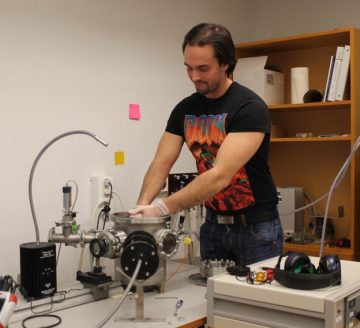
In 1938 Reino Laiho became the director of the Wihuri Physical Laboratory. At the time, he was studying magnetic materials and their properties. Related to these studies in mid-1980s a very sensitive magnetometer, a SQUID (Superconducting Quantum Interference Device), was built. It could measure extremely small magnetic fields.
In extreme coldness the resistance of some materials disappears completely and they are called superconductors. In 1986 researchers found a high-temperature superconductor YBa2Cu3O7 eli YBCO which becomes superconducting already at -181○C (92 K). This meant that it could be cooled with liquid nitrogen to reach the superconductive state. Liquid nitrogen is substantially cheaper and easier to handle than liquid helium.
- Because the laboratory now had a SQUID at their disposal Laiho quickly started a new area of research: high-temperature superconductivity study. The research focuses on the interaction between high-temperature superconductors and magnetism and how it could be enhanced in different applications. This research is still very active in this group.
- There is also another field of research in the group, which studies other materials crystal structures for example SFMOs (Strontium iron molybdenum oxide) crystal structure. The magnetic properties of these substances are studies with spintronics in mind.
In Wihuri Physical Laboratory all the samples (thin films) are self-prepared in the laser ablation chamber.
This groups research if located between basic research and applied science. The main goal is to study how the materials can be enhanced so that they could be used on applications.
Workshop and liquefying helium
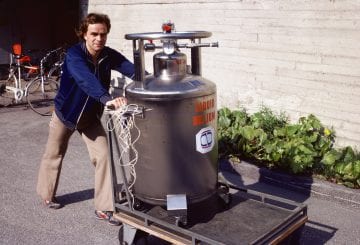
Along with the scientitsts there was also technical staff in the Wihuri Physical Laboratory. Nowadays its name is Protopaja.
One of the chores of the workshop was to provide liquid helium and liquid nitrogen for the use of the researchers. Nitrogen is no longer liquefied at the university, because it is relatively easy to liquefy directly from air. So its price per litre is very low, so it is supplied from outside the university. Previously before the move to Quantum they liquefied their own liquid nitrogen.
The workshops staff also helped the researchers to build, modify and repair necessary scientific equipment.
Helium liquefies at -269 ○C (4 K) so it works as an outstanding cooler in scientific research. But it is not easy to handle because it constantly aims to take its gaseous state.
The liquefier used by Wihuri Physical Laboratory is the only non-commercial helium liquefier in Finland and Wihuri is its biggest client.
If you want to know more about the history of Wihuri Physical Laboratory you can read the book: Wihuri Physical Laboratory: 60 years of low temperature physics in Finland. This summary is based on that book.